Implications of the Oil Prospects for Latin America

Table of Contents
Author(s)
José Antonio Ocampo
Former Nonresident FellowShare this Publication
- Download PDF
- Print This Publication
- Cite This Publication Copy Citation
Ocampo, José Antonio. 2018. Implications of the Oil Prospects for Latin America. Issue brief no. 11.09.18. Rice University’s Baker Institute for Public Policy, Houston, Texas
The strong rise of oil prices since the second half of 2017 raises myriad questions about the future of oil. In the short term, the question is what are the supply and demand prospects and whether prices will continue to be strong or will weaken. In the long term, there are contrasting scenarios. The first involves market trends, as analyzed by major institutions such as OPEC, the International Energy Agency (IEA), and the U.S. Energy Information Administration (EIA). The second relates to climate change debates, particularly with the agreed-to targets of the 2015 Paris agreement on climate change. As will be shown in this brief, market trends are inconsistent with the requirements to mitigate climate warming. Technological change may support meeting the climate change targets, but would involve a reduced demand for oil. The mix of good short-term prospects with long-term uncertainties has a clear policy implication for oil-dependent Latin American economies: use the larger short-term revenues to diversify.
Recent Market Trends
Benchmark crude prices climbed to a three-year high in January 2018 (see Figure 1, which shows the monthly evolution of Brent prices). Although they retreated during February and March, they climbed again, reaching new monthly peaks in May and September. In late September and through most of October, prices stayed over $80/bbl, but they fell again on October 23 (the time of the writing of this brief). Although this level is lower than that reached during the boom between 2011 and mid-2014, it is higher than typical prices over the past three decades. The common view that prices would moderate after the recent increase has been followed more recently by the opinion that they will possibly continue to increase, reaching levels not far from the previous boom.
Figure 1 — Brent Oil Prices, 1990–2018 (US$/Barrel)
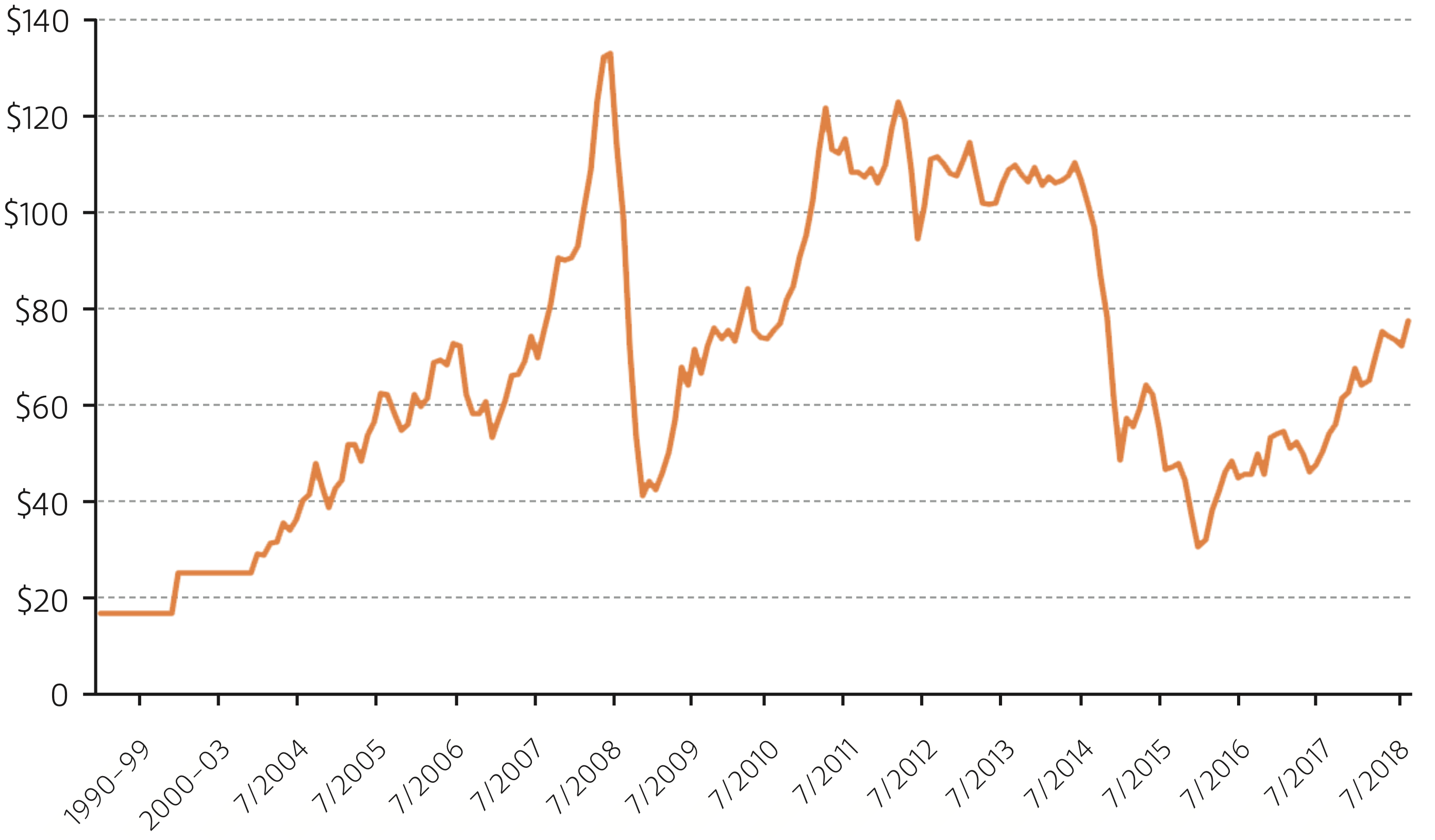
High crude prices reflect several supply shocks. They include sharp reductions in Venezuela’s production, the uncertainties related to Iran’s supplies due to the U.S. decision to break with the nuclear deal with that country, and the instabilities of Libya’s production. The production of Mexico and Norway has also been falling, following medium-term trends. These disruptions have not been offset by the rapid growth of U.S. production—associated with reduced costs of shale oil production—and increased supplies from Canada, Brazil, and Kazakhstan (International Energy Agency [IEA] 2018).
The recovery of prices was supported by the November 2016 OPEC agreement to cut oil supplies, which was joined in December by 11 non-OPEC countries, notably Russia. This is the most comprehensive output agreement since 2008 (IEA 2017a). The agreement was renewed in May 2017 and again in November 2017, when participants extended supply cuts through 2018. However, at the June 2018 ministerial meeting of the agreement’s members, the parties decided, in a somewhat ambiguous way, to increase supplies—or, more formally, reverse the over-compliance with cuts they had previously agreed to. However, in September 2018, they rejected the call by President Donald Trump to increase production. This generated, together with the uncertainties surrounding Iran supplies, a new price increase, which has been partially reversed with Saudi Arabia’s October 23 announcement that it will increase production.
On the demand side, oil consumption was strong until the first quarter of 2018 but has weakened somewhat since then. For the year as a whole, demand growth estimates by OPEC and the EIA are in the 1.4-1.6% range, similar to the 1.5% reached in 2017. Demand projections reflect the recovery of world economic growth and the fast rates of growth of China and India, the two major sources of growth in oil demand (Table 1). Demand growth in 2018 is slightly under half of the growth of world GDP (at market prices) of 3.3% (International Monetary Fund [IMF] 2018). If demand grows in the lower part of the range, the associated elasticity would be about 0.4, below the 0.5 typical between 1990 and 2016—a demand growth of 1.4% per year versus 2.7% world GDP growth (Table 1). However, this global elasticity reflects entirely different trends: a fall in European and Japanese consumption1 and moderate growth in the U.S. but very high demand growth in Asia, particularly in China and India, as well as the Middle East and Africa. As a result of these trends, non-OECD countries increased their share in the demand for oil from just over one-third of the world in 1990 to over one-half in recent years.
Table 1 — World Oil Consumption, 1990–2040
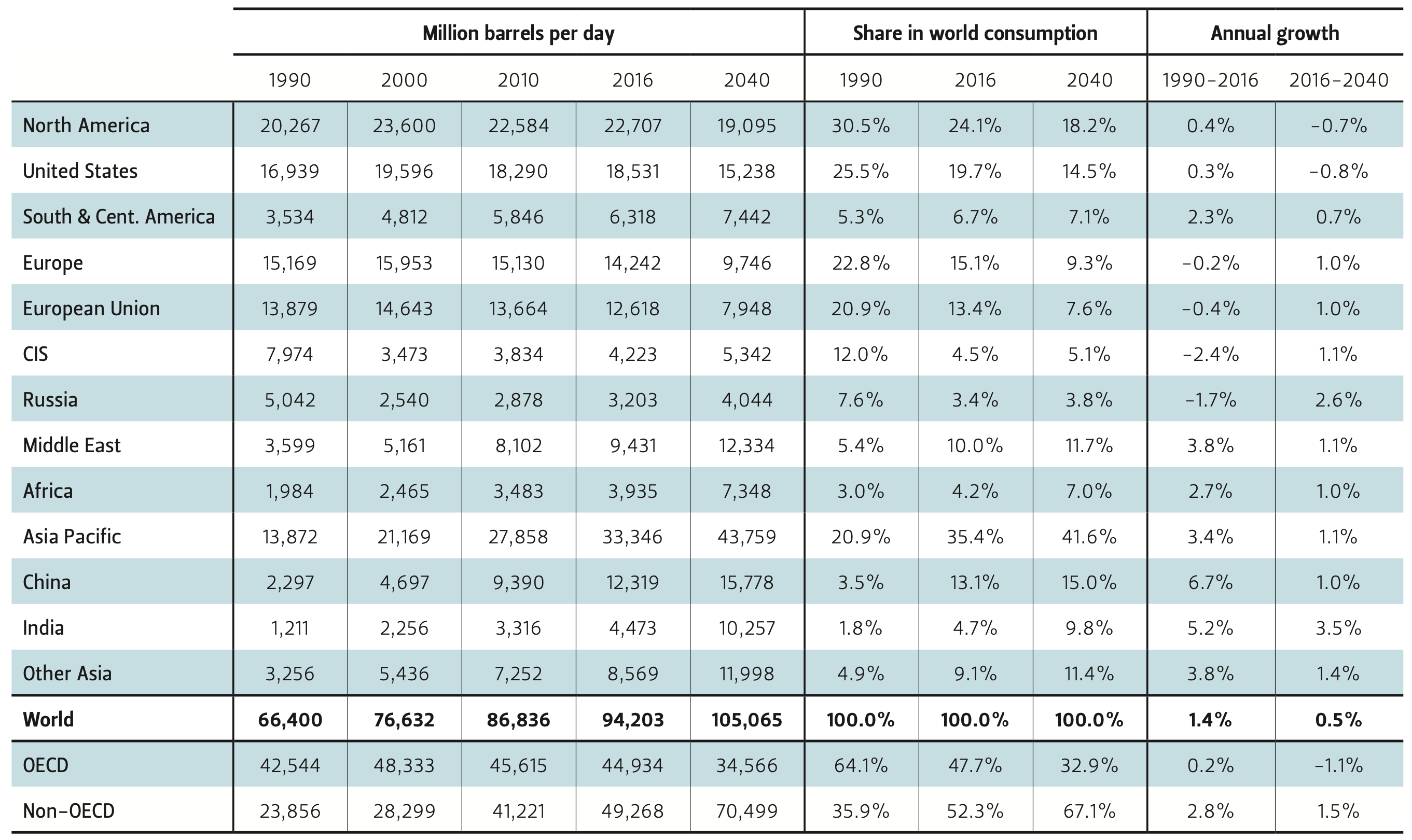
According to IEA (2017b), the factors affecting the energy market are rising energy efficiency, rapid deployment and falling costs of clean energy technologies, the growing electrification of energy, and the dynamics of shale gas and oil in the U.S. Energy intensity continues to fall due to the shift toward services and less energy-intensive industries. In its 2017 report, the IEA projected lower prices for a long period: $50-$70 for Brent crude through 2040. In contrast, the reference case price scenario of the EIA (2017) implied that Brent oil prices would show an upward trend and surpass $100/barrel by the mid-2030s.
Long-term Market Trends vs. Climate Change Scenarios
These considerations serve as background to the debate on the implications of oil demand—and fossil fuels more generally—for climate change. As Table 2 indicates, historical trends since the oil shocks of the 1970s have led to a reduction in the share of oil in primary fuel consumption, and a rise of natural gas, nuclear, and, to a still marginal extent, renewables; in turn, coal and hydro have kept their shares. Going forward, the 2018 projections by BP (Table 2) indicate that energy demand will slow down over the coming decades, renewables will start to weigh heavily in primary consumption, and natural gas will continue to grow in importance, with oil and, particularly, coal declining in relative terms. Overall, however, according to these projections, oil consumption will continue to increase in absolute terms over the next quarter-century.
Projections by IEA (2017a) provide a similar picture, with the growth of oil demand being robust until the mid-2020s but with a sharp reduction thereafter. As in the case of BP, this assumes a shift in energy policy in several countries toward electricity, with growing demand for natural gas and renewables for that purpose, and the broad shift toward cleaner, high-efficiency technologies. Projections by the EIA (2017) are quite similar, though they indicate a somewhat less optimistic scenario about the role of renewables.
In all projections, China and (to a lesser extent) India play fundamental roles in the growth of energy consumption and its composition among different fuels. The decision by the U.S. to abandon the 2015 Paris agreement and its more recent changes in energy policy facilitating coal production and reducing targets for the energy efficiency of motor vehicles may affect those projections, given the fact that the U.S. is still the world’s largest consumer of energy, oil in particular (Table 1).
What these market trends imply is that, despite the rise of renewables, more energy-efficient technologies and the shift toward services and less energy-intensive economic activities, CO2 emissions will continue to increase through 2040, although at a gradually slower pace. These trends contrast, of course, with the 2015 Paris agreement, which committed the world to a target of keeping a global temperature rise this century below 2°C above pre-industrial levels, and to pursue efforts to limit the temperature increase even further, to 1.5°C.
These targets are based on the fact that, according to all existing studies, keeping the global temperature below 1.5-2°C of preindustrial levels is crucial to maintain climate change within the limits of manageable risks, and that a temperature rise to near 4°C—which would be reached if consumption patterns are not radically modified—would be catastrophic.2 Staying within the 1.5-2°C range (the “CO2 budget”) requires major changes in energy and production systems, not only in developed countries but also in emerging and developing countries where demand is growing and will grow fastest (Tables 1 and 2).
Table 2 — Primary Energy Consumption by Fuel, 1970–2040

In the case of oil, for example, existing projections indicate that all the increase in demand over the next quarter-century will come from non-OECD countries; in fact, the demand from OECD countries—including the U.S.—is expected to decrease.
The estimates from the Energy Transitions Commission shown in Figure 2 (Copenhagen Economics 2017) indicate that there is a need for an immediate and sharp reduction in coal consumption of about 80% by 2040. Oil consumption should peak in the 2020s but should then decline by one-third by 2040, and natural gas consumption could increase moderately. However, if there are no advances in carbon capture and storage (CCS) of coal emissions, oil consumption would have to fall by 45% (from 92 million barrels per day [MBD] to 51 MBD in 2040), largely limiting its use to transportation (heavy-duty road transport, aviation, and shipping) and chemical production.
A study of 15 major countries by the Institute for Sustainable Development and International Relations (2014) indicates that most of the expected energy emission reductions would be achieved after 2030. A 50% decline by 2050 from 2010 levels would require an almost total de-carbonization of electricity generation by the mid-century, increased electrification of residential energy, electrification of transportation (less so in freight transportation), and limited reduction of energy use in industry.
The requirements to reach climate change targets contrast, of course, with market trends, which, as we have seen, show no expected reduction in coal consumption and an increase in oil consumption. In fact, meeting the climate change targets requires that a large part of the proven fossil fuel reserves be un-utilized (“stranded”). This is particularly true of coal reserves, given that its use generates the largest relative CO2 emissions per unit of energy and also produces air pollution. These requirements would be alleviated if CCS technologies were put in place. However, there is the associated investment in infrastructure to capture CO2 and store it in geological formations—and many of the associated technologies are at a research and development phase, or at best in a pilot stage.
Existing commitments to reduce emissions are clearly insufficient. The likely emission reductions from the nationally determined contributions (NDCs) under the Paris agreement cover only about one-third of the emissions reductions needed (United Nations Environmental Programme 2017). These projections imply that 80% of the CO2 budget to keep temperatures below 2°C will have been used by 2030, and the percentage required for 1.5°C will have been depleted. Meeting the NDCs would guarantee the stagnation of emissions, but not the reduction needed starting in the 2020s to reach the 2°C target, and would lead to a temperature rise of 3°C or more by 2100.
According to the last published report of the Intergovernmental Panel on Climate Change (IPCC 2018), the 1.5°C limit requires a 45% decline in CO2 emissions from 2010 levels by 2030 and zero emissions by 2050. In turn, meeting the 2°C target would require a decline in CO2 emissions of about 20% by 2030 and zero emissions by 2075. The world is not on the path to meet either of these targets; even if the current commitments under the Paris agreement are met, temperatures will rise 3°C by 2100 and continue to rise after that.
There is, therefore, an urgent need to accelerate short-term action and enhance longer-term solutions. Hence, NDCs must be strongly revised according to the schedule for 2020 and the U.S. should return to the Paris agreement and reverse its recent energy policy decisions.
Figure 2 — Fossil Fuel Consumption to Meet the 2˚ Climate Equivalent Goal, 2010–2040 (Million Tons of Oil Equivalent)
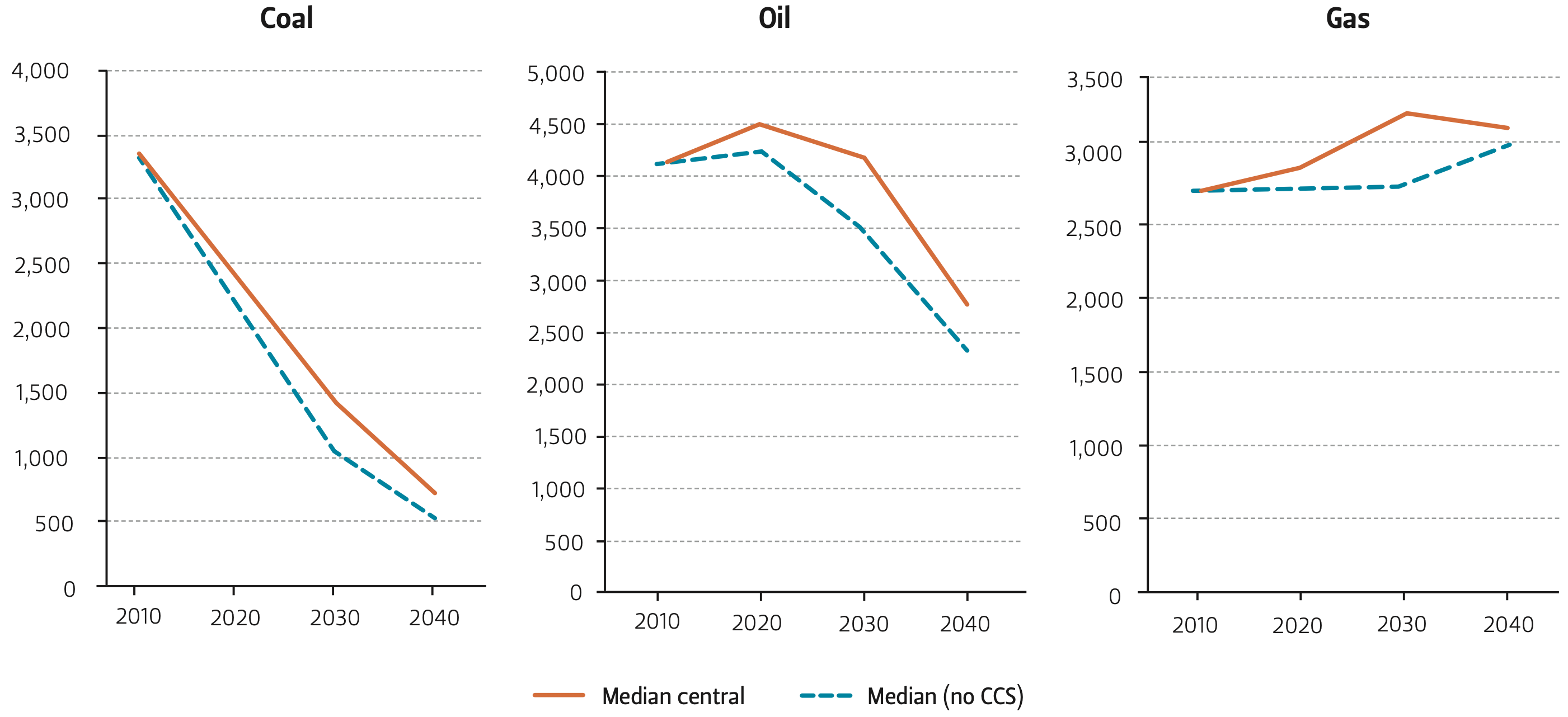
Technological change will play an essential role in this process. According to UNEP, significant advances can be obtained in the short term with well-known technologies, such as solar and wind energy, efficient appliances and cars, afforestation and stopping deforestation. As a group, these short-term solutions can meet about 40% of the reduction needed by 2030.
Even more important is the longterm potential impact of the technological revolutions under way, a topic that has been analyzed by Cherif, Hasanov, and Pande (2017). Three complementary elements of this process include: 1) a transport revolution which, under a fast adoption scenario, implies that electric vehicles (EVs) will make internal combustion vehicles obsolete in OECD countries by the early 2040s, with a lag of 10 to 20 years in non-OECD countries; 2) the spread and reduced cost of renewables in electricity generation; and 3) the development of lithium batteries (and perhaps other types of batteries), which is essential for the first two developments to consolidate gains.
Figure 3 — Oil Production in Latin America, 2003–2018 (Million Barrels per Day)
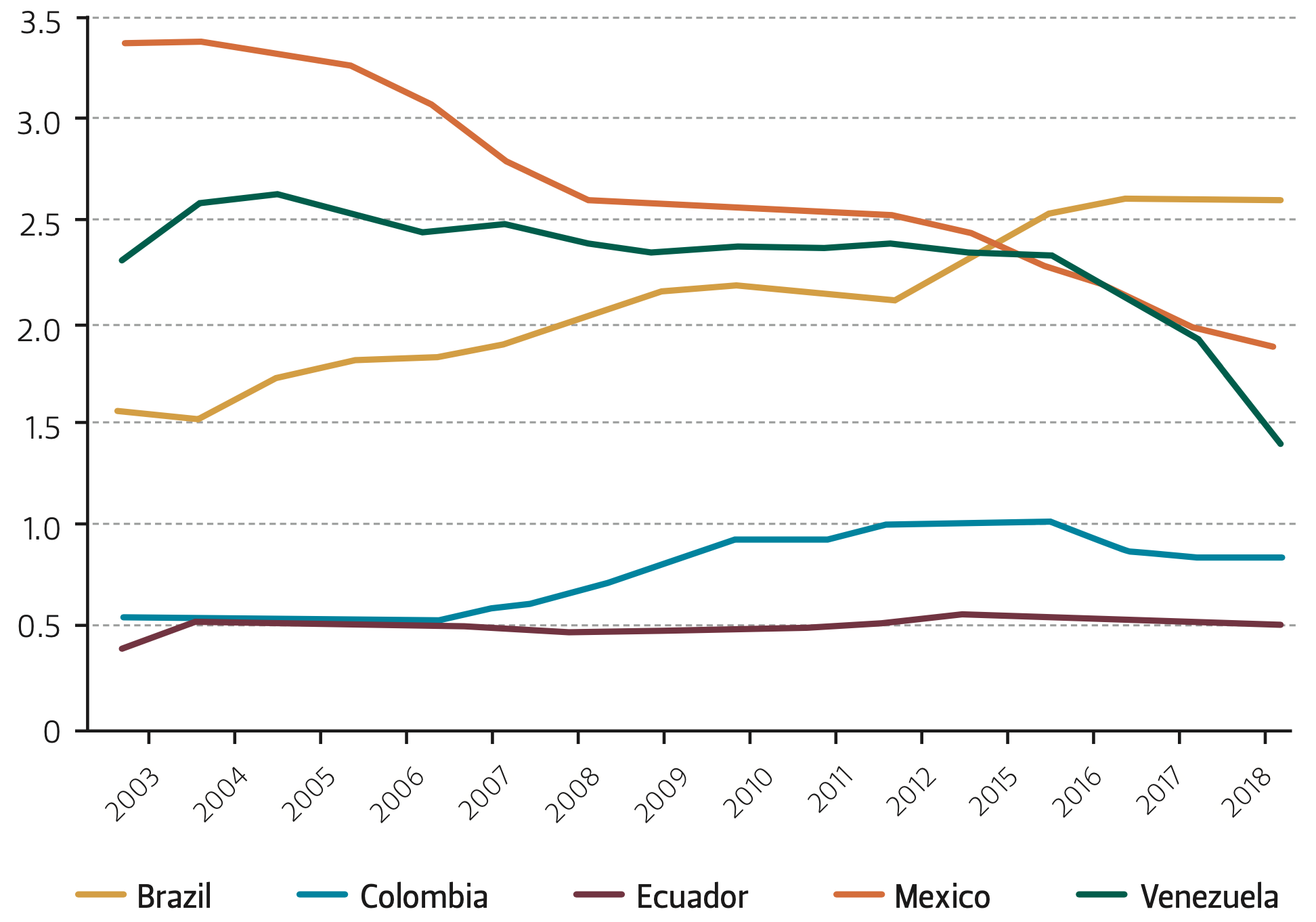
The simulations by these authors take as a reference the energy revolution of the early 20th century.3 Given the transportation sector’s central role in the demand for oil, lower oil use in OECD countries would have the strongest impact and could be accompanied by a reduction in the demand for oil in non-OECD countries—if there is also a rapid adoption of EVs, a possible scenario given the fact that China is already the largest market for EVs. The main result would be a sharp reduction in oil demand from the late 2020s to the early 2040s. This would be accompanied by a dramatic reduction in price, as oil use becomes confined to petrochemicals and some heavy transport activities.
What this suggests is that the rapid development and spread of new technologies is essential for the world to meet climate change targets and that, therefore, policies should reinforce these actions. In regard to oil demand, this also means that market projections are not fully taking into account the implications of technological changes under way.
Implications for Latin America’s Oil-Producing Countries
The five major Latin American oil-producing countries have played very different roles in the world oil economy in recent times (Figure 3). In terms of additional oil supplies, the major contributions have been those of Brazil and, to a much lesser extent, Colombia in 2008-13. However, this has not compensated for the sharp reduction in Mexico’s production since 2006-07 and the veritable collapse of Venezuelan production in recent years. That collapse took place in two steps: the first, in early 2016, was associated with the difficulties of maintaining production in the high-cost oil Orinoco Basin oil fields; the second, since September 2017, was related to effects of U.S. financial sanctions and the loss of human capital in the oil industry (Torino Economics 2018, pp. 8-13). Ecuadorian production has remained stagnant and that of Colombia fell in recent years, though it has stabilized in 2018. Together, the production of these five countries in 2018 is expected to be 11.7% below 2003 levels, and 15.6% below those of 2013.
The sharp reduction in prices since 2014 has had very differential effects on these economies, given their diverse dependence on oil exports and fiscal oil revenues and the divergent evolution of their production just mentioned. The economies most dependent on oil for exports and fiscal revenues are Venezuela and Ecuador (Table 3). This is followed by Colombia (which depends on oil more for trade than fiscally) and Mexico (more fiscally). In all these countries, the price collapse has had pronounced effects. Brazil has also been affected, but less so; it is less dependent on oil and the effects of falling prices have been partly compensated by rising oil production and exports. Given the central role of state oil companies in all these countries, the different effects are closely interconnected.
This diversity also implies that the recent recovery of oil prices will also have different effects on these countries. Most are benefiting heavily in the short term, with the mix between export and fiscal revenues varying across countries. This is not true in the case of Venezuela due to the domestic and external factors previously mentioned, with the former being perhaps relatively more important. In fact, the recent sharp reduction of production in this country suggests that oil export revenues will again decline in 2018 despite rising prices (Torino Economics, 2018, Table 5, p. 18).
Table 3 — Latin American Dependence on Oil, 2008–2017
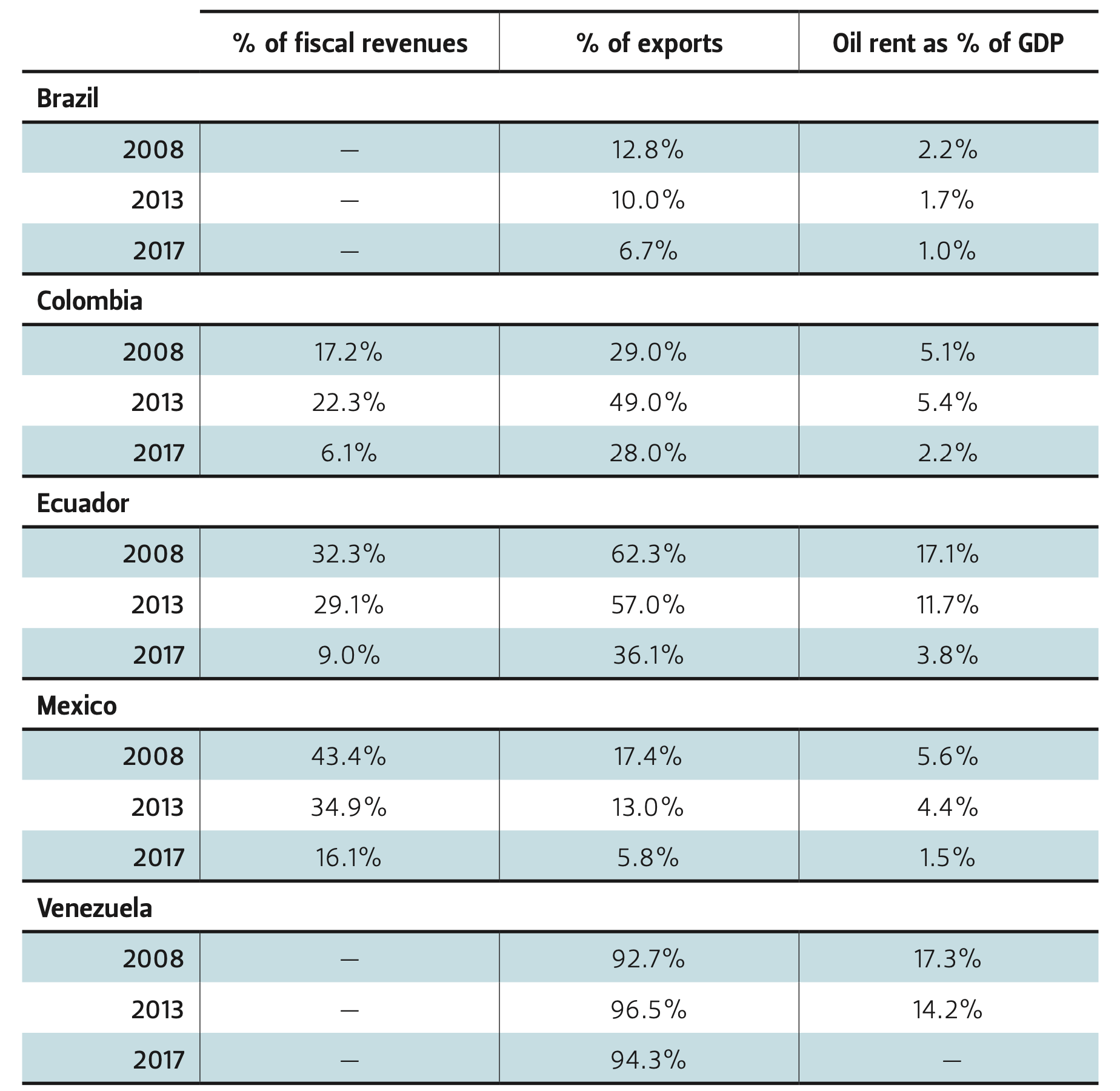
Source See Figure 3. Oil rents according to World Bank.
Figure 4 — Projected Oil Production, 2015–2040 (Million Barrels per Day)
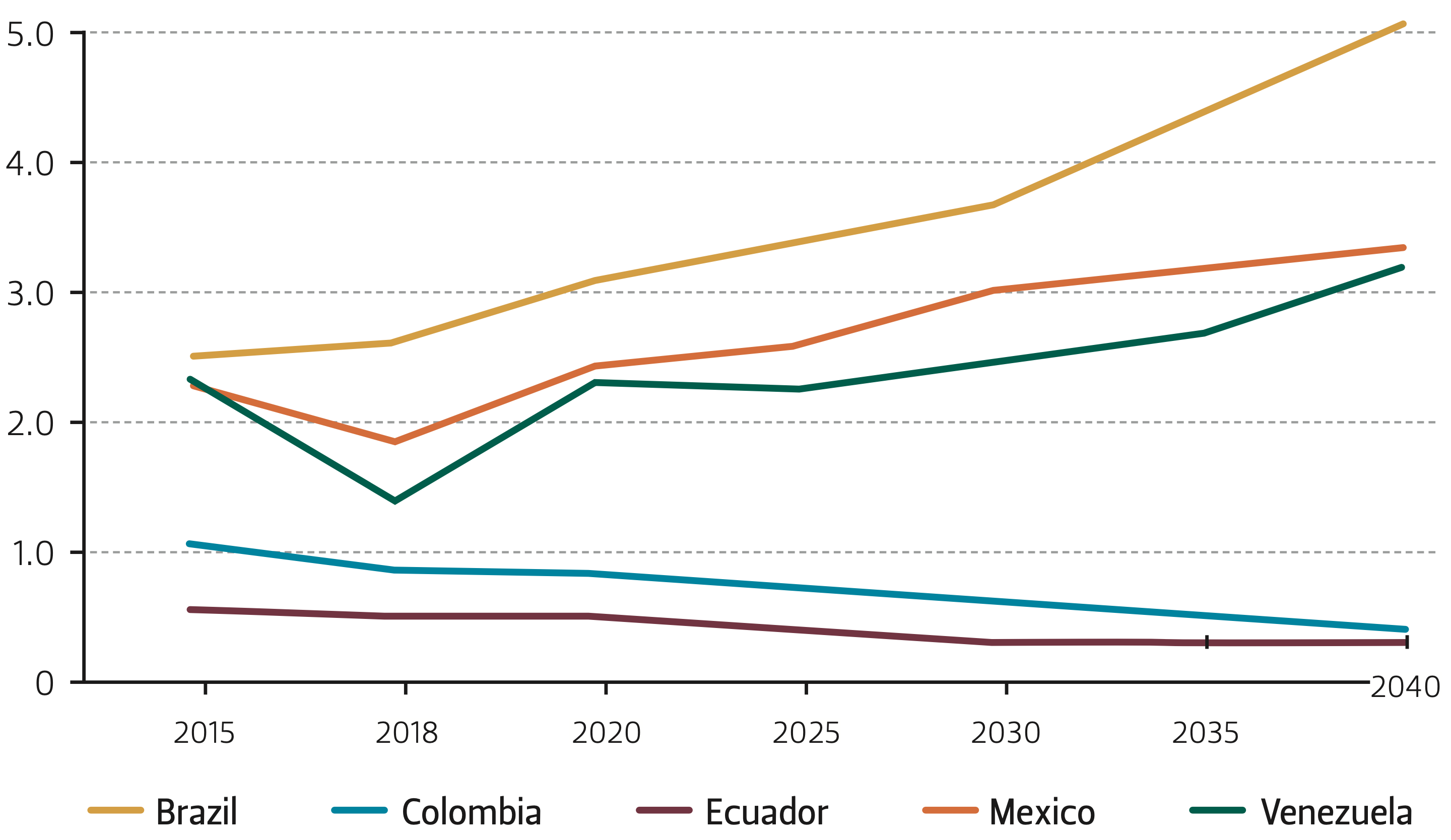
The long-term scenarios are highly uncertain. In terms of production, current projections for the three major producing countries in Latin America are very optimistic (Figure 4). The trends in Brazilian production are the most likely to continue. The trends for Mexico reflect the changes in oil policies in recent years, which imply the possibility of more investment and the participation of new agents in the market—both private firms and the state oil firms of other countries, including those of Latin American partners. The policies of Mexico’s incoming president, Andrés Manuel López Obrador, will be crucial to realize the potential of this trend.4 In contrast, the projected recovery of Venezuelan production is highly unlikely, at least in the short term, and depends on whether major political changes take place in the country. And in contrast to the positive trends projected for these countries, the production of Colombia and Ecuador is expected to fall, but these trends may be compensated for by policy decisions—some of them controversial, as reflected in the recent debate in Colombia on whether to allow fracking.
Beyond the uncertainties surrounding future production, the contrast between different long-term scenarios at the global level—the market-based ones, the requirements associated with climate change mitigation, and the effects of the technological revolutions under way—must be on the agenda of Latin American oil producers. The major simple recommendation for Latin America’s oil-dependent economies is to diversify, and to use higher short-term oil revenues to do so. This means developing a strong non-oil export sector, new sources of public revenues, and developing new renewable energies on a large scale. The first change is particularly important for Colombia, Ecuador, and Venezuela, and the second is particularly important for Mexico. Developing new sources of renewable energy is also a major recommendation for the state-oil companies of all these countries. This will also help these countries contribute to climate change mitigation—although in the case of Latin America, energy issues are somewhat less important in this regard than land use and deforestation (Economic Commission for Latin America and the Caribbean 2015). As in the rest of the world, Latin American governments should guarantee that the energy transition takes place at a steady pace by strongly supporting the diffusion of the technological revolutions under way.
References
BP. 2018. BP Statistical Review of World Energy, 67th edition, June.
Cherif, Reda, Fuad Hasanov, and Aditya Pande. 2017. “Riding the Energy Transition: Oil Beyond 2010.” IMF Discussion Paper WP/17/120, May.
Copenhagen Economics. 2017. “The Future of Fossil Fuels: How to Steer Fossil Fuel Use in a Transition to a Low-Carbon Energy System.” Research paper produced for the Energy Transitions Commission, London, January.
Economic Commission for Latin America and the Caribbean (ECLAC). 2015. La economía del cambio climático en América Latina y el Caribe, Santiago.
Energy Transitions Commission. 2017. Better Energy, Greater Prosperity: Achievable Pathways to Low-Carbon Energy Systems, London, April.
Institute for Sustainable Development and International Relations (IDDRI) and Sustainable Development Solutions Network (SSDN). 2014. Pathways to Deep Decarbonization, Paris, September.
International Energy Agency (IEA). 2017a. Oil 2017: Analysis and Forecasts to 2022, Paris.
______ . 2017b. World Energy Outlook 2017, Paris.
______ . 2018. Oil Market Report, August 10.
International Monetary Fund (IMF). 2018. World Economic Outlook, October.
Intergovernmental Panel on Climate Change (IPCC). 2018. “Global Warming of 1.5°C.” Geneva: World Meteorological Association and United Nations Environmental Program, October 6.
Organization of Petroleum Exporting Countries (OPEC). 2018. World Oil Outlook 2018, Vienna.
Torino Economics. 2018. “Ecuador & Venezuela this Week,” September 24.
United Nations Environmental Programme (UNEP). 2017. Emissions Gap Report 2017, September, Nairobi.
U.S. Energy Information Administration (EIA). 2017. International Energy Outlook 2017, September.
Endnotes
1. Japan is not disaggregated in Table 1. On the other hand, Russia also shows a decline in demand between 1990 and 2016, but this was the result of its strong recession during the transition process; its demand has again turned positive during the past decade.
2. In this regard, it should be added that 2017 was the second-hottest year on record, according to NASA experts (the warmest without El Niño), and that 17 of the 18 warmest years have taken place since 2001. See The New York Times, January 18, 2018, https://www.nytimes.com/interactive/2018/01/18/climate/hottest-year-2017.html.
3. The authors take as a reference the disappearance of horses as a major form of transportation in the first half of the 20th century, and the spread of oil versus coal from the 1920s.
4. Announcements on October 15, 2018, indicated that he was planning for Mexico to stop exporting oil.
This material may be quoted or reproduced without prior permission, provided appropriate credit is given to the author and Rice University’s Baker Institute for Public Policy. The views expressed herein are those of the individual author(s), and do not necessarily represent the views of Rice University’s Baker Institute for Public Policy.


